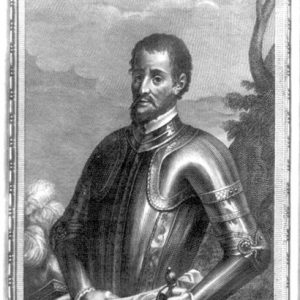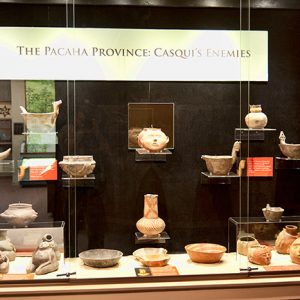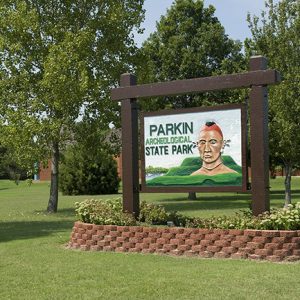calsfoundation@cals.org
Parkin Historic Site
The Parkin Historic Site is a seventeen-acre Native American village site along the St. Francis River in Cross County. Archaeological and geographical information indicates that it is probably the location of the town of Casqui mentioned in the narratives of the Hernando de Soto expedition, which passed through northeast Arkansas in the summer of 1541. In recognition of its national significance, the Parkin site was designated a National Historic Landmark in 1964 and has been on the National Register of Historic Places since 1966.
The site is at the north end of Parkin and is the main focus of Parkin Archeological State Park. The Arkansas Archeological Survey established a research station at the site in 1990, and research on the site is ongoing. Archeologists discovered that the village was first settled between about AD 1000 and 1250. It was established along the banks of the St. Francis less than a mile downstream from its confluence with the Tyronza River. This location was valuable not only for its strategic importance but also because the soil was well suited to farming.
The Indians planted their fields along the river. Excavations have revealed that corn was the main crop, supplemented by beans, squash, sunflowers, and tobacco. The Indians also stored many wild plants from the area, including pecans, persimmons, and various seeds and fruits. Their primary source of meat was deer, which were abundant in the forests that covered the region. In addition to many smaller mammals, fish and turtles from the rivers provided food.
Their success at farming and the area’s natural abundance supported population growth over hundreds of years. Other Indian groups in the region were also prospering and expanding, and competition for prime farmland and the desire of chiefs to expand their domains eventually led to warfare. By the time Spanish explorers arrived in the 1500s, chiefs were ruling over “provinces” consisting of ten to twenty small villages, and these settlements were fortified for defense. The Parkin site is a prime example of one of these fortified Mississippian villages. A defensive moatlike ditch surrounded the settlement on three sides (with the St. Francis on the fourth), and archaeologists excavated remains of a stockade wall of upright wood posts on the inside edge of the ditch.
Its size and strategic location suggest that the Parkin Site was a capital, with about twenty smaller villages surrounding it. These villages were also fortified, and similarity of pottery styles and other archaeological remains support the conclusion that the residents were part of a single culture.
Study of Spanish accounts of the de Soto expedition indicates that the Parkin Site is probably the village of Casqui described in the accounts. The expedition arrived on July 4, 1541, and had an unusually friendly encounter with the Indians. The next day, de Soto had Catholic priests conduct a mass, and a large cross was erected atop the mound where the chief’s house stood. Archaeologists have found what may be part of this cross, although it is impossible to prove beyond doubt.
Spanish artifacts, including a glass bead, a brass bell, bell fragments, and two lead shot, provide strong evidence for contact between the residents of Parkin and the de Soto expedition. The Spanish accounts state that the chief was named Casqui, and he ruled over a province of smaller villages. He was at war with the chief of a neighboring province called Pacaha. If Parkin is indeed the site of Casqui, it is significant because it is the first place in Arkansas for which we have a written description of the initial contact between Arkansas Indians and Europeans.
For additional information:
Mitchem, Jeffrey M. “Mississippian Research at Parkin Archeological State Park.” In Proceedings of the 14th Mid-South Archaeological Conference, edited by Richard Walling, Camille Wharey, and Camille Stanley. Special Publication No. 1. Memphis: Panamerican Consultants, 1996.
Morse, Phyllis A. Parkin: The 1978–1979 Archeological Investigations of a Cross County, Arkansas Site. Research Series No. 13. Fayetteville: Arkansas Archeological Survey, 1981.
———. “The Parkin Archeological Site and Its Role in Determining the Route of the de Soto Expedition.” In The Expedition of Hernando de Soto West of the Mississippi, 1541–1543, edited by Gloria A. Young and Michael P. Hoffman. Fayetteville: University of Arkansas Press, 1993.
Jeffrey M. Mitchem
Arkansas Archeological Survey
 Hernando de Soto
Hernando de Soto  Parkin Archeological State Park
Parkin Archeological State Park  Parkin Archeological State Park
Parkin Archeological State Park 



Comments
No comments on this entry yet.